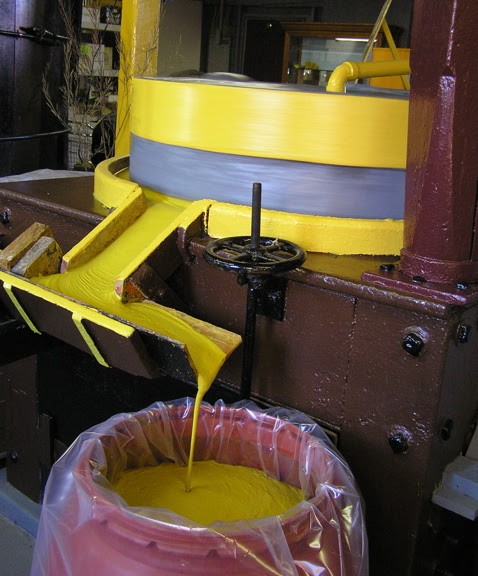If you’re like ninety percent of Americans, you have mustard in your kitchen. Not so a hundred years ago. Back then, most mustard in the US was sold as a powder to be “constituted” at home—and it was really hot. In the 1880s, Robert French, he of the most common mustard brand in the states, had the idea that Americans would prefer a milder mustard. Though Robert passed away before he could see his idea come to life, at the 1904 St. Louis World Fair his brother introduced a fairly mild, creamy mustard. Copying the most popular British mustards of the day, he added turmeric to make his mustard bright yellow. Business took off. A century later Americans are still wolfing down fairly mild yellow mustard.
Nostalgia for summers at the ballpark aside, most yellow mustards are pretty boring. They’re thin, they taste more like vinegar than mustard seed, and the flavor doesn’t last too long. But that doesn’t have to be the case. Take Raye’s Down East Schooner mustard. It tastes just like you’d expect yellow mustard to taste, but more mustardy—more yellow. The flavor is complex, and it lasts a long time.
Raye’s makes their mustard with a century-old set of 2,000-pound quartz millstones.
The set of eight stones was quarried and carved in France in 1900, and J.W. Raye started making mustard with them in Eastport, Maine that same year. The eight stones make four mills: one stone lays flat while the second stone slowly spins above it, grinding the mustard seed, water, and vinegar into a paste. It’s nearly the same process that was traditionally used to make olive oil (and is still used by a very few oil producers, like Roi). Each batch of mustard passes through all four mills, getting smoother and creamier with each pass. Because the stones grind slowly, the temperature stays low, keeping more of the volatile compounds of the seed intact. These days, most mustard is made with machines that either crush the seeds at super high speeds or heat it up, essentially cooking it. The result is increased yields but decreased flavor.
Raye’s is the only mustard maker in the US using traditional stone mills, but that’s not the only thing that differentiates them from the rest of the yellow mustard pack. They’re still using the same recipe they developed 114 years ago. One ingredient in that recipe is water from a 400-foot deep well. That well water is very cold—ground water absorbs the sun’s heat, but well water stays chilly in the cool ground all summer long just like a basement stays cooler than the rest of the house. The cold water helps to keep the temperature down during milling. After the mustard is made, it’s stored in big barrels for about six weeks before being jarred. Aging the mustard like that mellows its heat level a bit and creates a more balanced flavor. In contrast, commercial yellow mustard is bottled in less than a day. Even small-batch, hand-crafted mustards are generally bottled after just a couple of days.
As an aside, the aging barrels used to be made of wood. Raye’s actually used to employ a cooper just to make all the barrels. But then a while back the FDA decided that wood was a no-go and the barrels needed to be made from plastic instead. The same issue has been up for discussion lately in the cheese world, with concern as to whether the FDA would ban the practice of aging cheese on wooden planks. However, unlike the decision for mustard barrels, it sounds like wood isn’t leaving the cheese caves any time soon.
Raye’s is the house yellow mustard used on sandwiches at Zingerman’s Deli.
Zingerman’s cofounder Ari Weinzweig’s favorite sandwich, the Oswald’s Mile High, has just three ingredients: corned beef, Jewish Rye bread, and Raye’s mustard. Its full flavor makes it great for slathering on a sandwich with brisket, pastrami, salami, cheddar, you name it; if it’s got a lot of flavor, Raye’s can match it.

